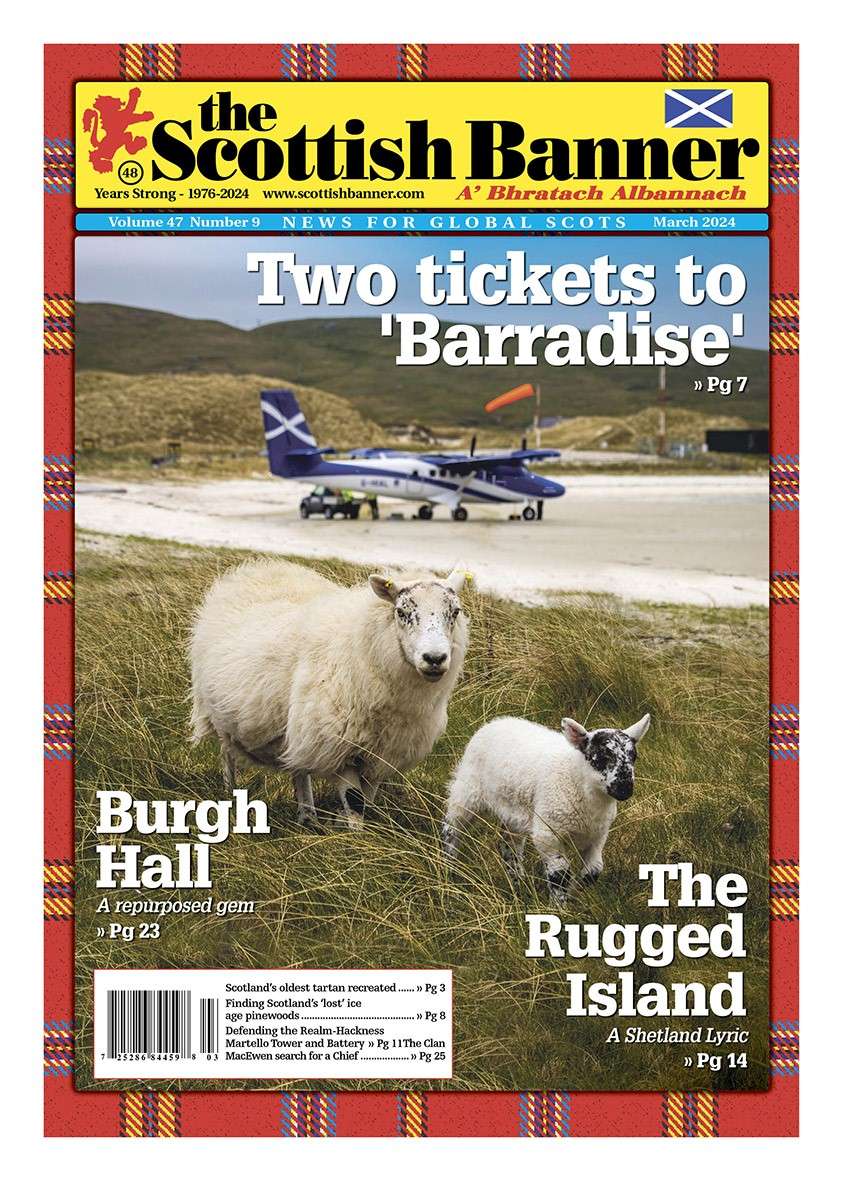March- 2024 (Vol. 47, Number 09)
The Banner Says…
Celebrating a Celtic mosaic
-

The welcoming commitee on Barra. Photo VisitScotland/Kenny Lam.
Scotland is a land of rugged landscapes, ancient castles, dramatic history and haunting bagpipe melodies and certainly has its very own unique and rich culture, but it also shares deep-rooted connections with other Celtic nations.
Celtic DNA
A letter we ran in the February edition caught my eye as our reader claimed to mostly be Scottish but also had a ‘Celtic DNA mosaic” and ‘a healthy dose of Irish, Welsh and English’ flowing through them. I am sure many of us do, and some may not be aware of how far reaching our Celtic bloodlines travel. I know our family blood is multi-generational Scottish but can also be traced back to the cathedral town of Letterkenny in north-west Ireland for example.
This month some of our Celtic family celebrate their unique, but linked, cultures. The Welsh will be celebrating the life of their patron saint, St David, and the Welsh culture on March 1st. Saint Piran’s Day is celebrated each year on 5th March in Cornwall and the Irish will be out in full force on March 17th in a sea of green celebration.
Part of tradition
Whilst there is no one ‘Celtic language’ there is an estimated two million speakers of the six Celtic languages in existence (Breton, Cornish, Irish, Manx, Scottish Gaelic and Welsh). Irish (Gaelic) speakers are by far the highest of that number, with an estimated over one million speakers. This is followed by Welsh and Breton speakers. Scottish Gaelic (Gàidhlig) comes in fourth and is a language we highlight regularly in this publication, and the Highlands and islands remain strongholds of Gaelic culture in Scotland. Positively more than 1.5 million people have started learning Scottish Gaelic on Duolingo (a language learning app) since it launched four years ago. Finally Manx and Cornish round up the six Celtic languages still spoken today.
Storytelling is a big part of all Celtic cultures. What Celt doesn’t love to tell a tale, these parts of social history are passed down generation to generation and weave themselves into the story of the nation and part of tradition. Legends, folklore, mythology, facts and fiction all create enchanting tales of magic, heroes, and otherworldly creatures for Celts. Cornwall, Scotland and Wales all lay some claim to King Arthur for example. While the Irish, Scots and Manx all share the mythological Celtic ancestor, Cailleach, the veiled goddess of winter.
Of course, one place we all revel in storytelling is in Celtic music, the stories, humour and sense of place a melody can give is an integral part of any Celtic nations culture and melody.
In this issue
International Women’s Day takes place this month on March 8th, we are again highlighting another great Scottish female trailblazer. Pioneering Glasgow-born filmmaker Jenny Gilbertson created documentary films of a Shetland life that is no more. She also went on to make her mark on Canadian film. You can catch her work this month in Scotland or from home via a special livestream.
One of Orkney’s many historic sites is Hackness Martello Tower and Battery which was built to protect British convoys in the early 1800s. Fortunately the site never had hostile action happen, but it does offer a unique insight into what military life was like more than 200 years ago.
Dunoon Burgh Hall opened in 1874 to celebrate the conferring of Burgh status for the town and was built to provide the local community with a public hall, municipal offices, and the very first theatre in Argyll. Over the last 150 years this Category B-listed Scottish Baronial landmark has hosted numerous events and been a focus for community celebration and connection and we are fortunate to highlight yet another great Scottish historic building.
Celtic spirit

The link Scotland has with other Celtic nations, transcends borders, and is woven through a history, language, culture, and a shared sense of Celtic identity. Whether through folklore, music, landscapes, food or shared struggles, these bonds remind us that the Celtic spirit endures and we certainly all share some common ground with one another.
Scotland of course runs through the veins of most reading this, and the Scottish Banner itself, but that does not mean we don’t intertwine, celebrate, champion and appreciate the incredible Celtic cultures found across the Celtic nations. Celts travelled far and wide before borders were a thing, and perhaps many of us can link our bloodlines across Europe. Could you have more than just Scottish ancestry and your blood line links to Ireland, Wales, the Isle of Man, Cornwall, Brittany or Galicia? Beyond that of course many may linto a variety of European and beyond ancestries.
Being a Celt is like being part of an even larger family, and that surely must be one of the great aspects of our shared Celtic spirit.
Do you have a variety of Celtic ancestry? Do you follow any Celtic traditions outside of Scottish? Do you have you any comments from the content in this month’s edition? Share your story with us by email, post, social media or at: www.scottishbanner.com/contact-us
#ScottishBanner, #TheBanner
The Scottish Banner is more reliant than ever on our readers helping us to provide you with our unique content by buying a copy of our publication, regardless if by print or digital subscription or at a retail outlet.
We appreciate your support and hope you enjoy this edition.
